On 23.12.2011, Alexandra Historical Auctions President Bill Panagopulos wrote in yet again by email, attaching several images in support of his contention that the Wintex wristwatch recently offered through his auction house was the engraved watch presented by Benito Mussolini to Otto Skorzeny in thanks for his rescue from Gran Sasso on 30.9.1943. Asked again if he wished to avail himself of of the right-of-reply we offer to anyone wishing it, and to explain the material he had sent in, Mr Panagopulos responded the next day:
Afraid I cannot continue this love story. I’ve given you all the info you asked for, and now you want me to write essays for you? Frankly, I have better things to do.
I gave you all the evidence you asked for. You did not even comment upon it. Now I have to move on.
Your demands are not unlike me being forced to prove that Castro DIDN’T plot JFK’s murder.
Do the right thing.
Bill Panagopulos
President
Alexander Autographs, Inc.
Alexander Historical Auctions LLC
Criticized by Mr Panagopulos for failing, as he saw it, to common upon the images he had supplied and challenged to “do the right thing”, we decided that the Wintex wristwatch alleged to have been presented to Otto Skorzeny by Benito Mussolini merited a second article. Mindful of Mr Panagopulos’ attempt to gag us by making a baseless complaint about copyright infringement to the ISP based on our use of images of the watch from his catalog, we took photographs of a computer screen displaying one of the several websites where these images can also been viewed.
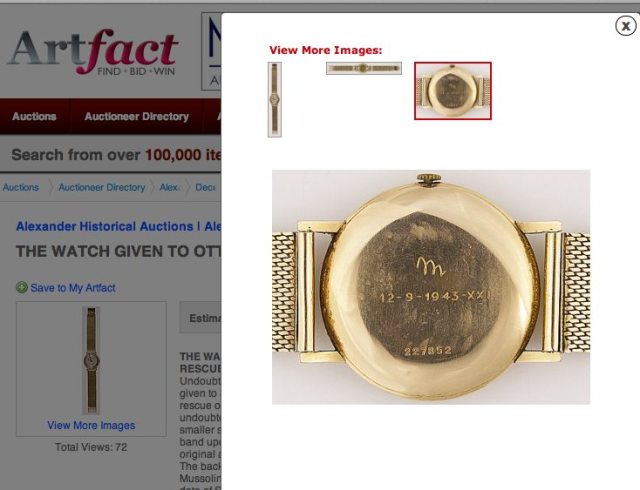 |
| Copyright © W C Stump Blog |
Even if the person dealing with Mr Panagopulos’ complaint was unaware of Fair Use and Public Domain exemptions in international copyright legislation, we feel that there can be no equivocation in this case because we hold copyright in the above image, of which we are the authors. We also assert our copyright in other images bearing our copyright notice. If Mr Panagopulos and the owner of the wristwatch in question have any objections to make, we would advise them to make similar complaints to the ISPs of all of the websites on the catalog images appear. The fact that they have not apparently done so suggests that their objections were aimed at gagging us because we were posing awkward questions about their $40,000 “Gran Sasso” wristwatch.
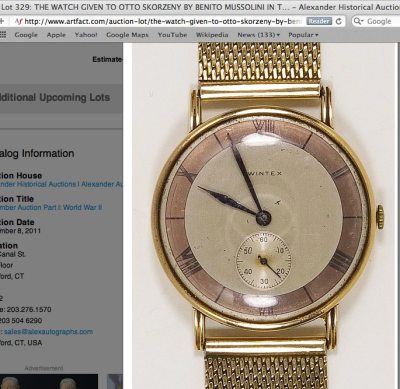 |
| Copyright © W C Stump Blog |
This in turn raises the question of why the auctioneer and his client would wish to gag us. If our questions are as ludicrous and ill-founded as Mr Panagopulos has repeated claimed in a barrage of abusive, threatening and often barely coherent emails, why not simply ignore us? However, Mr Panagopulos has sent us various images, asking us to comment upon them and to “do the right thing”, and we now propose to acquiesce to his demands. These images comprised the following items: scans of two pages from a typewritten draft of Skorzeny’s memoirs; two copies of Spanish newspaper reports from 1961 of a meeting in Madrid between Skorzeny and Benito Mussolini’s son; four stills from the US Army Counter-Intelligence Corps film of Skorzeny’s interrogation.
Referring to my article about alleged Mussolini ‘Gran Sasso’ watches, Mr Panagopulos wrote: “You once again demonstrate your ineptitude. If Skorzeny had the “Mussolini” watch on Aug. 2, 1945, then how could it have been “stolen” from him the previous May? Because it wasn’t. We have literally thousands of pages of Skorzeny’s writings in our possession. Included is a typed manuscript of his memoirs, date unknown, ca. 1955-1960, approx. 825pp. 4to. with multiple corrections in several unknown hand (possibly editors), several pencil corrections and additions in Skorzeny’s hand. Attached you will find “OS-1”, a typed page from the memoirs bearing Skorzeny’s additional note at bottom. “OS-2” shows the theft of his “Omega sports watch”.
 |
| Copyright © W C Stump Blog |
OS-1 shows Page 354 of a typewritten draft of Skorzeny’s memoirs, published by various imprints in various forms since the early 1950s. The typewriter on which this draft was produced was evidently not a German machine, as the lack of use, for instance, of the umlaut shows. The unknown editor’s corrections appear in ballpoint pen. Although in German, there is no use of the umlaut, indicating that the editor might not have been a native German speaker, which is logical. The additional notes to which Mr Panagopulos refers could be by Skorzeny. Germans and Austrians have long been taught standardized forms of handwriting. However, we shall address this point further on.
 |
Copyright © W C Stump Blog
OS-2 shows page 331 of a typewritten draft of Skorzeny’s memoirs, which seems to have been produced on the same typewriter, judging, for instance, by the misalignment of certain letters. This part of his memoirs describes the point at which the Americans surrounded him with leveled machine guns in a room in their divisional headquarters in Salzburg and strip-searched him, following his surrender to US Army soldiers on 16.5.1945. On this page, we find the following statement: Vorerst weigere ich mich einzusteigen und verlange energich den Offizier wegen meiner Uhr zu sprechen. Die Uhr, eine gute Omega-Sportuhr, habe ich waehrend des ganzen Krieges getragen. Sie ist mir zu vertwoll um darauf zu verzichten. Endlich kommt der Offizier und findet auch heraus, ver von Soldaten die Uhr.hat. [sic].
|

Otto Skorzeny might have worn an Omega Sport Watch during the Second World War. It was a popular choice of chronograph for military men and Omega certainly supplied chronographs like the example above to the Oberkommando der Wehrmacht during the war. These were in stainless steel and are extremely rare. The Omega Sportuhr was, on the other hand, a civilian chronograph and came in various forms and styles. The top of the range came in 18k gold with three sub-registers, like the example below. And we know that Skorzeny was partial to chronographs because wartime and postwar photographs, including the well-known snapshot of him at home in Ireland in the 1960s, clearly show twin-button chronographs. The Irish photograph shows such a watch, which could be an Omega or even a Breitling Navitimer. The images are not clear enough to form any definite conclusion. However, the watch examined by the US Army intelligence officer in the 1945 film seems to be a fairly ordinary men’s dress watch of the period.
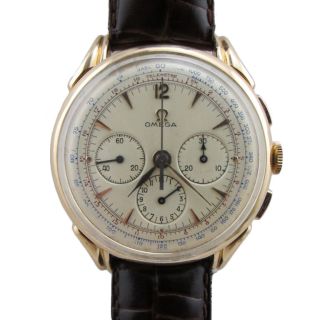
There is no getting around the fact, regardless of this draft of Skorzeny’s memoirs, that in the early 1950s Skorzeny told Charles Foley, author of Commando Extraordinary (Longmans Green 1954) that the watch taken from him in Salzburg, then returned, stolen a second time and never seen by Skorzeny again was the watch given to him by Mussolini. Foley reported what his subject told him. None of the published versions in various languages by various imprints since 1950 mention this theft of an Omega Sport Watch.

Skorzeny died on 5.7.1975. Albin Michel (France) had published his memoir My Commando Operations – French title La guerre inconnue – on 28.2.1975. The draft was translated into French by Maurice-Yvan Sicard alias Saint-Paulien, a French fascist living in exile in Spain who had been sentenced in absentia to life imprisonment with hard labor by a French court in 1946. The previous memoir by Skorzeny, translated by Max Roth and published in 1950 by the French imprint Flammarion, had been serialized in the French daily newspaper Le Figaro, provoking rioting outside the newspaper’s offices in Paris. As an upper middle class product of Hapsburg Austria, the Skorzeny family spoke excellent French and Otto Skorzeny was no exception, as several interviews prove.
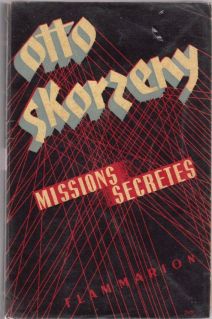
Even the most recent 1995 edition in English of Skorzeny’s memoir, published in 2005 the USA by Schiffer, contains no mention either of the Omega to which the draft supplied by Mr Panagopulos refers. It does however contain paragraphs describing Benito Mussolini’s gift to Skorzeny of not one but three engraved watches commemorating the Gran Sasso rescue mission; a gold chronograph, described as a “stopwatch”, a wristwatch and a pocket watch with the initial M inlaid with rubies. The wristwatch is said to be the same type given by Mussolini to every one of the men who landed on the Gran Sasso plateau during the mission. There is evidence to suggest that Mussolini sent engraved wristwatches to some of the Fallschirmjäger and SS-Jagdverband officers but none indicating the gift of engraved wristwatches to the hundred-plus gliderborne rescuers.
Attached to the email of 23.12.2011 from Bill Panagopulos were scans of photocopies of two Spanish newspapers that carried this report on Friday, 3.3.1961:“I again attach the pages from the 1961 Spanish newspapers citing the Spanish news service report of Skorzeny meeting showing Romano Mussolini and showing him the watch given to Skorzeny by Benito Mussolini. You irresponsibly failed to report these newspaper citations in your libelous blog page.”

On Thursday, 2.3.1961, the CIFRA news agency circulated a report of the meeting in Madrid that day between Romano Mussolini, son of the late Benito Mussolini, and Otto Skorzeny: The report translates as follows: Romano Mussolini and Otto Skorzeny were reunited in Madrid after eighteen years. The meeting was very emotional. The recalled times past, and Skorzeny enquired after the Mussolini family. He also showed Romano a wristwatch given to him by the Duce, who had ordered it engraved with his signature and the date on which he had been liberated by Skorzeny.
While the reports indicate that Otto Skorzeny was in possession on 2.3.1961 of a wristwatch engraved with Mussolini’s name or, to be precise, as “firma” can refer to a signature or a monogram, Mussolini’s monogram and the date of the Gran Sasso mission, they do not prove that this was the actual wristwatch given by Mussolini to Skorzeny in October 1943. It is for observers to evaluate the level of probability in the context of Skorzeny’s well-established penchant for self-promotion and selling fake Skorzeny memorabilia to collectors.
Mr Panagopulos continued: “I did not edit nor translate Skorzeny’s memoirs from German to English. What I do know is that I have a set of typed memoirs from Skorzeny’s massive (paper) estate, with his manuscript corrections within, that those memoirs state that an “Omega” watch was taken from him in May. 1945, and that in August, 1945 he was filmed with a watch identical to the one we have. Attached are four photographs from the film of Skorzeny’s interrogation at Dachau on Aug. 2, 1945. Two have been marked by me. You will need a large, high-quality monitor to clearly see the items marked. (BTW – I obtained them easily – you are apparently too impecunious to purchase them:
SkorEv1’ shows the following:
A/ Otto Skorzeny, aghast.
B/ The “Mussolini” watch with original leather band (later replaced with the gold “mesh” band)
C/ The bronze-coloration and Roman numerals on the outer edge of the dial face
D/ The second smaller circular dial indicating elapsed seconds.
Note that the time appears to be 7:40.
SkorEv2” shows the following:
A/ Otto Skorzeny, no longer aghast.
F/ The “cyclops” crystal (also evident in “SkorEv1”)
As the watch is being held at a more obtuse angle in this image, the smaller “elapsed seconds” dial is less evident here.
Note that the time again appears to be 7:40.
Your libelous website reads: “…As the still from the US Army CIC film shot shows, Skorzeny still had his Mussolini watch on 2.8.1945, when his interrogation was filmed…”. In the next paragraph, you state that in his memoirs, Skorzeny claimed that he was given three timepieces and his “Mussolini watch” was: “…stolen from him after he surrendered to US forces near Salzburg on 20.5.1945. He writes that he ‘had it returned to him but that it then disappeared again, this time for good’…”
Otto Skorzeny told Charles Foley and others that the watch presented to him by Mussolini was stolen from him in Salzburg but returned when he protested to a US Army officer. He also stated that it subsequently disappeared for good and did not challenge Foley when he published these remarks in 1954. Why should he have challenged them? He made the same remarks on many occasions, before he established something of a trade in Otto Skorzeny memorabilia, at which point muddying the waters was clearly to his advantage. The US Army CIC film shot in Dachau on 2.8.1945 shows that Skorzeny still had the watch presented to him by Mussolini. In a previous email, Mr Panagopulos had written:
On May 15, 1945 Skorzeny and Radl are sent to Werfen where they are interrogated by two American officers and a translator. They are forced to surrender their possessions, are searched, and then are returned their possessions, except for his wristwatch which he describes as: “…a good Omega sport watch, which I wore throughout the whole war…”. He protests the theft, gets the watch back, and then it disappears again. That’s the watch you cite in your so-called research, my skin-headed friend. His memoirs (here) state that he had no way to tell the time after his watch was stolen…but how did he get (our) watch filmed when he was interrogated in Dachau on August 2, 1945? Did his “mummy” send it to him? More likely, it was with his possessions, which probably were in storage and went with him to Dachau (as he also states in his memoirs). He dug the watch out because his Omega had been stolen from him.
The memoirs draft in Mr Panagopulos’ possession might well state that Skorzeny had no way of telling the time after his watch was stolen but Mr Panagopulos neglected to send a copy of the relevant passage. However, let us examine Mr Panagopulos’ thesis. He rightly dismisses the possibility that Skorzeny’s mother sent him the Mussolini watch while he was in captivity. Skorzeny was married and his wife, whom he divorced after his escape in order to marry Ilse Finckenstein in 1950, is still alive. She has stated that he had no contact with her husband during his captivity.
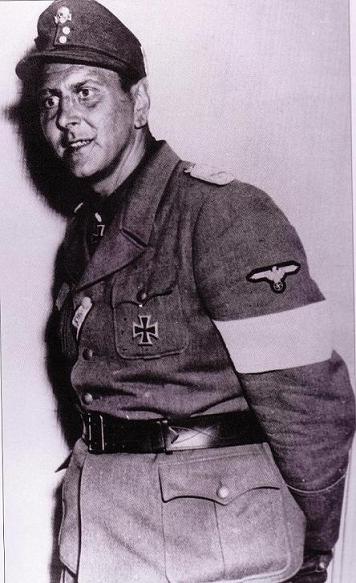
As for Mr Panagopulos’ contention that Skorzeny was carrying his possessions around with him like a captured general officer, the reality is that Skorzeny and the three officers who descended from the abortive Alpine Redoubt ten days after the surrender were travelling light. The above photograph shows how Skorzeny was dressed when he presented himself to US forces near Salzburg. He has not yet been strip-searched and robbed of his medals. So this photograph was taken minutes after his arrival at the US Army divisional headquarters in Salzburg.
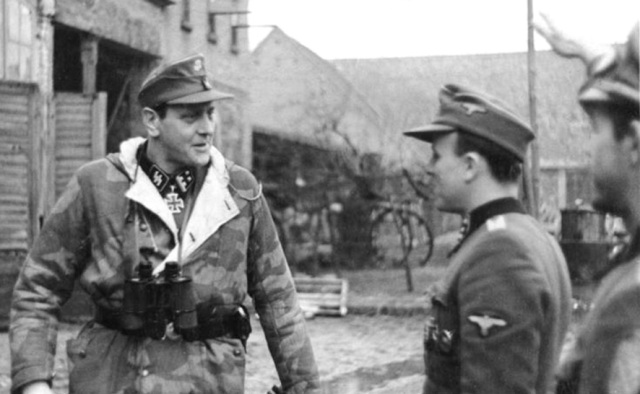
The above photograph was taken on the Oderfront in April 1945 and shows SS-Sturmbannführer und RKT Skorzeny much as he would have looked when he descended from the mountains near Salzburg a few weeks later. He is wearing an army-issue parka, with a Waffen-SS-issue officer’s field belt, on which there is a holster containing his P38 automatic. He wears a 1940-pattern Waffen-SS officer’s field tunic with major’s rank badges. In May 1945, when he surrendered, he was wearing an open-collar tunic with no collar patches, he and his comrades having decided that it might be wise to remove the SS runes, given warnings that Allied forces tended to execute surrendering Waffen-SS men in a summary manner. Skorzeny and his comrades, including his adjutant Radl, were travelling light, in field order. They might have had a couple of rucksacks containing blankets, bivouac equipment and food. They intended returning to their men after locating American forces. As it turned out, they were placed under arrest as if they were common criminals and did not return to their units. So much for Mr Panagopulos’ presumed notions of Skorzeny accompanied by some sort of personal baggage train as if he were a surrendering Field Marshall.
However, all of these are moot points because none of the theses proffered by Mr Panagopulos explain away Skorzeny’s references in the early 1950s to the attempted theft of his Mussolini watch by an unknown American soldier, the serial theft attempts and the final, successful theft of the watch, which he stated he never saw again. As for his meeting with Romano Mussolini in Madrid in 1961, it is quite likely, as anyone familiar with Skorzeny’s personality can confirm, that he did show the late dictator’s son a watch bearing the Gran Sasso inscription but how certain can serious students of Otto Skorzeny be that this was the actual watch given to him by Benito Mussolini in October 1943?
The stills from the CIC film supplied by Mr Panagopulos as proof that the Wintex wristwatch offered by Alexandra Historical Auctions is that same watch examined by the CIC officer are indeed quite clear, though by no means clear enough to establish the marque and type of watch worn by Skorzeny that day, no matter how large a monitor one uses. They are clear enough to show that the watch worn by Skorzeny on 2.8.1945 and the watch offered for auction through AHA on 8.12.2011 seem quite different
 |
|
Copyright © W C Stump Blog
|
 |
|
Copyright © W C Stump Blog
|
A comparison of the wristband lugs alone suffices. They seem quite different in design. The watch in the film has tapered, solid wristband lugs whereas the Wintex has straight, fluted lugs. The bezel surrounding the crystal of the watch in the 1945 film seems wider than that of the Wintex. The crown of the watch in the 1945 seems larger than that of the Wintex. The extract from the second still supplied by Mr Panagopulos provides an even clearer image of the watch examined in Dachau by the CIC officer on 2.8.1945. The dial could be two-tone but this could just as easily be due to shadows. However, a comparison of the wristband lugs suffice to indicate that the watch filmed in August 1945 is not the same as the watch offered in 2011 by Alexandra Historical Auctions. If his previous remarks about the differences between the alleged Munich Pact Desk Set he brokered and the one photographed in 1938 are any indication, Mr Panagopulos will attribute this to our lack of understanding of photographic perspective, before threatening legal action. On the other hand, it suggests that Mussolini gave Skorzeny a simple gold wristwatch rather than a chronograph as there is nothing in these images to suggest the presence of any sub-registers or a stopwatch function. This wristwatch could have been made by any number of firms. If anything, it looks like a 38mm gentleman’s Doxa from the late 1930s, a type popular with well-heeled members of the “Fast Set” and gentry.
Coming back to the scans of two pages of the typewritten draft supplied by Mr Panagopulos, it is clear that they were typed on the same machine, which is evidently not a German typewriter, as the lack of use of the umlaut indicates. The corrections in ballpoint pen do not incorporate the umlaut either, which could just be a house style decision on the part of the editor. The other annotations in a lighter ink, possibly using a fountain pen, evoke a standard form of handwriting taught in Germans and Austrian schools up to the 1960s and 1970s and could have been added by Otto Skorzeny.
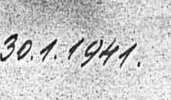

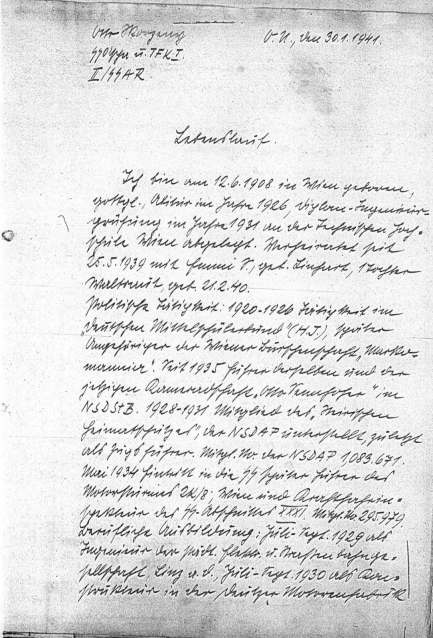
However, although people’s handwriting can change over the years, there are a number of fundamental differences between these notes and, for example, the curriculum vitae written by Skorzeny for his SS personnel file on 30.1.1941, on the eve of his commission as an SS-Untersturmführer in II./SS-Artillerie-Regiment “Das Reich”. Note for instance the way in which Skorzeny formed the number 4 in 1941 and how the number 4 in the draft is formed. The difference is radical. Compare the number 3 from 1941 to the number 3 as allegedly written on by Skorzeny on the draft in the possession of Mr Panagopulos, a draft alleged to date from there 1950s and which recounts a different version of the theft of Skorzeny’s ‘Mussolini watch’ to those published since 1950, and which introduces an Omega Sport Watch. It seems strange that none of the published Skorzeny memoirs and accounts match the extracts from the draft of which Mr Panagopulos sent us sample pages. Mr Panagopulos states this draft to date from 1955 to 1960 yet where does it fit into the tangled web woven by Otto Skorzeny himself and by various fantasists advancing all sorts of theses about Skorzeny’s involvement with Hyman Roth, the Great Train Robbers and so on and so forth?

This 1940 advertisement shows the first fully waterproof Omega chronograph, a type coverted by military men of all nations during World War Two. Omega produced similar watches in 18k gold. Can we expect to see exciting reports of the discovery of an Omega Sport Watch in the possession of the family of a wartime Counter-Intelligence Corps officer or NCO, complete with Otto Skorzeny’s name and SS-Nummer scratched into the inside of the back cover? Complete, perhaps, with a letter from the deceased veteran admitting that he liberated it as war booty from The Most Dangerous Man In Europe or that Skorzeny gave it to him as a present for looking the other way when he was sprung from the Darmstadt camp by former comrades disguised in US Army uniforms? And a story about how Old Scarface told him during their chats in prison that he bought himself this wonderful gold chronograph by Omega when he was commissioned? Or when he won the Iron Cross 2nd Class? As the current crop of dealers and auctioneers attempting to pass all of these Third Reich personality items onto the market have shown us, anything is possible.
And as Otto Skorzeny himself showed us after the war, anything is possible when it concerns Skorzeny memorabilia. Skorzeny’s reputation for self-promotion was well known, as was his prolific trade in fake or enhanced Skorzeny memorabilia. The Wintex watch in question might have belonged to Skorzeny. It might even have been bequeathed to his widow as the Alexandra Historical Auctions catalog blurb states. Bill Panagopulos of Alexandra Historical Auctions might truly believe that the Wintex wristwatch he offered on 8.12.2011 is the watch featured in the US Army CIC film shot on 2.8.1945. It could even be the watch shown by Skorzeny to Romano Mussolini in Madrid in 1961. The evidence, however, suggests that the Wintex is not the watch presented in October 1943 to Otto Skorzeny by Benito Mussolini. At best, it is a watch Skorzeny had engraved as a prop for dinner table anecdotes or to gull yet another of the American collectors lining up to buy any old rubbish he foisted on them. As such, it could be described as a Skorzeny-related curio.
In any case, as already remarked, postwar photographs of Skorzeny taken in Spain and also in Ireland quite clearly show him wearing a chronograph wristwatch with cylindrical buttons resembling those on the 1940 Omega in the above advertisement and those on other postwar chronographs containing Valjoux movements. We have yet to see a postwar photograph of Otto Skorzeny wearing a wristwatch like the one in the Dachau film or the Wintex. As for the apparent belief of the auctioneer and his client that the Wintex is the watch given by Mussolini to Skorzeny in 1943, the evidence suggests otherwise. It could be any marque amongst dozens of watches of this style, popular from the mid-1930s to the mid-1940s. The author has a 1938 gold Doxa wristwatch resembling the watch in the Dachau film, which was taken by one of General Patton’s intelligence officers from a German Lieutenant-General in 1945. Doxa’s wristwatches were considered very classy, certainly more so than a Rolex bargain basement sub-brand like the Wintex. And there remains the awkward question of the visible differences between the wristband lugs of the watch in the Dachau film and the watch defended so resolutely by Mr Panagopulos, an auctioneer who could never be accused of failing to defend his clients’ interests, to the point of threatening, abusing and defaming anyone who dares to ask awkward questions about some of the merchandise he handles.
To be continued…
WCS


















Duh…idiots please learn history…Skorzeny was given an engraved POCKETWATCH by Mussolini, so a one of a kind item…Gold Wristwatches were given to all of Skorzeny’s troops involved in the raid…so still pretty cool…but a lot more common as over 150 troops were involved in the raid, there were paratroopers and Waffen SS involved, so not sure how many wristwatches were actually given out by Mussolini.